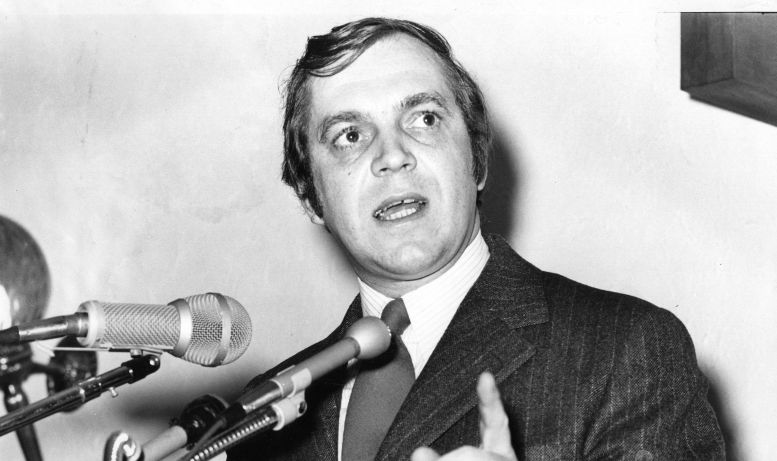Ed Broadbent, leader of the federal NDP from 1975 to 1989, is often described as the “best prime minister Canada never had.” Maybe that’s an example of being damned with faint praise. It is certainly not aiming at a high bar, given many of the country’s Prime Ministers. Despite that, Broadbent undoubtedly made a strong impact on public life in Canada and that deserves recognition.
Was he a loser?
Broadbent received a state funeral on January 28. He resigned as leader after four general election campaigns, feeling he had let the party down and was not in a position to take it further. In a world where parliamentary politics has increasingly become a zero-sum game, Broadbent would be seen as a loser. And yet on a personal and political level his legacy stands much higher than so many of the so-called winners of that era and the winners in subsequent parliaments. This is because Broadbent’s influence can be measured in how he used his position to advance key principles that have made a lasting impact. He put the issue of poverty on the national agenda. He insisted on pushing through the recognition of Indigenous Rights in the Charter despite Prime Minister Pierre Trudeau’s deep opposition.
Broadbent also campaigned and made popular the phrase “corporate welfare bums” that Lewis, former NDP leader, had used in the 1972 election. Today Canada is awash with corporate welfare with at least $43.6 billion in subsidies to electric battery plants alone.
Boosting the seat count
In the 1979 federal election, the NDP under Broadbent boosted their seat count from 17 to 26 seats. In the 1980 election nine months later, Broadbent’s NDP again experienced a boost of support from 27 to 32 seats. After that election, Liberal leader Pierre Trudeau proposed a coalition government with the NDP although the Liberals had won a working majority. Broadbent, to his credit, declined this offer as it would have tied the NDP to Liberal policies (too bad the NDP didn’t do the same in 2022 over the current Liberal-NDP deal). In the 1984 federal election, the NDP finished with 30 seats, just ten behind the Liberal Party led by John Turner.
After this election, Broadbent was the most popular party leader. Prior to the Layton ascendancy, Broadbent was the most successful and popular NDP leader since Tommy Douglas. In 1987, he led the NDP to being the most popular party in public opinion, for the first time in history. At the time, some pundits thought that the NDP could supplant Turner’s Liberals as the main opposition to the Brian Mulroney-led Progressive Conservatives. In 1989, Broadbent supported Mulroney’s proposed Meech Lake Accord (which proposed recognizing Québec as a distinct society and extending provincial powers), which led to some dissent within the NDP.
Stepping down
Broadbent led the NDP to 43 seats in the 1988 federal election, a record unchallenged until the 2011 federal election, when it won 103 seats (the so-called orange crush) under the leadership of Jack Layton. However, this was seen as disappointing compared to the pre-election polling support. The party did not achieve a breakthrough, remaining in third place behind the second-place Liberals. Broadbent faced criticism for not campaigning harder on the NDP’s opposition to the Canada–United States Free Trade Agreement (superseded by NAFTA). This became the main issue in the campaign and the Liberals successfully but falsely presented themselves as the main opposition. The Liberals in 1993 supported the NAFTA negotiated by Mulroney.
Broadbent stepped down as leader in 1989. When Jack Layton ran for the NDP leadership in 2003, Broadbent’s support for Layton was a significant coup for the latter’s campaign and the most visible example of his significant support in the party establishment. It marked a continuity of centre right politics within the NDP with the leaderships of Layton, Mulcair and Singh being part of this continuity.
What could have been — the Waffle
Prior to his election as leader, Broadbent exhibited a trajectory that was common to many social democratic politicians — starting off on the left and then moving steadily rightwards. At a federal NDP convention in 1969, the 33-year old Broadbent witnessed the delegates rejecting a resolution, inspired by a rank-and-file party group known as the Waffle, that called for an independent socialist Canada. The Waffle could be described as a predominantly youth movement that espoused both Canadian nationalism and solidarity with the Québec sovereignty movement. In debating a draft version of the Waffle manifesto, Ed Broadbent reportedly said, “if we are going to waffle, we better waffle to the left,” which explains how the manifesto and the group got its name.
Broadbent developed some left-wing credentials by an initial association with the Waffle, but it did not last long. After initially participating, he walked away from the group “for the excess of its 1969 manifesto, which noted the importance of the ‘American empire.’” In fighting the Waffle, Broadbent and other establishment NDP figures demonstrated just how far they were prepared to go to reject even the mildest criticism of their Party program — be it on Québec’s right to self-determination, the women’s struggle or military pacts like NATO and NORAD. In Broadbent’s case, it wasn’t just a case of growing disaffection with the Waffle, it had become outright hostility. In 1972, the provincial council of the Ontario NDP adopted a motion, prepared by Broadbent, which expelled the Waffle.
After Being a Politician
Broadbent, like other politicians, seemed to move more to the left after leaving elected office. He founded the Broadbent Institute in 2011 to provide research and information from a social democratic viewpoint. It has championed the transition to a green economy and a taxation system that tackles the huge inequality in Canada.
However, he also endorsed Brian Topp, an NDP bureaucrat, for leader in the 2012 contest after the death of Jack Layton. Thomas Mulcair won that contest and moved the party further to the right, which resulted in a sharp drop in support for the NDP in the 2015 election, going from the 103 seats it won in 2011 to 44, and its share of the vote falling from 31 to 20 percent.
It’s about more than being Mr. Nice Guy
Ed Broadbent came across as a “nice guy” who cared. But if you are going to play the role of a working-class leader, that is not enough. Broadbent’s politics were not socialist, and he did not espouse class struggle. Broadbent used to define himself interchangeably as either a democratic socialist or a social democrat. On November 1, Broadbent gave what would turn out to be his last interview to a national audience. The host asked him whether he still considered himself a socialist. “Yes,” he confidently replied. Too bad that, as leader of the NDP, this confidence was rarely seen. Too bad that he never really understood what being a socialist meant.
He was a product of his times and a product of the party he led. As Socialist Alternative wrote in March 2022, just after the current Trudeau-Singh Liberal-NDP pact had been negotiated:
“The problem with the NDP is that it sees everything through the lens of elections and parliamentary arithmetic. Further, its vision is short-sighted. It does not campaign day-to-day in communities and workplaces. There are no big rallies like in the Bernie Sanders’ election campaign. The malaise is at the top, accompanied by the lack of a vibrant organization at the bottom, which has been the case for some time. Its vision is progressive but not bold. It backs away from challenging the basic power relations in society: the working class versus those who own the means of production. It continually underestimates the ruthlessness of the elites. Its methods are not class struggle. Tommy Douglas cautioned: ‘We must never underestimate our opponents; nor should we forget that the closer we come to reaching our objectives, the more vicious and forthright will their opposition become.’”



